Forklift aisle widths correspond to the technical specifications provided by forklift manufacturers, which include data on each type and model of machine they sell. These specs can be used to obtain the data needed to design an installation, for example with drive-in racks. The key data are the width of the aisle required to operate the machine, the lifting height for the load, and the height of the retracted mast. These specifications also provide information on load capacity.
Lifting height
One piece of information in technical specs that requires particular attention is the lifting height, which is the distance between the ground and the upper part of the fork.
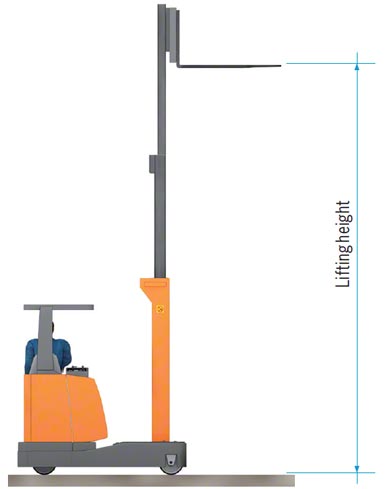
Forklift aisle width and lifting height of equipment
To calculate the maximum height of the top rack level, one must take into account the fact that when the forks pass between the pallet skids, part of the pallet is positioned under the fork. This means the support rail for the top level must be at least 200 millimetres below the maximum lifting height.
This ensures that when the mast is fully extended upward, the pallet is lifted to the height needed for the skids to avoid the beam and not hit it.
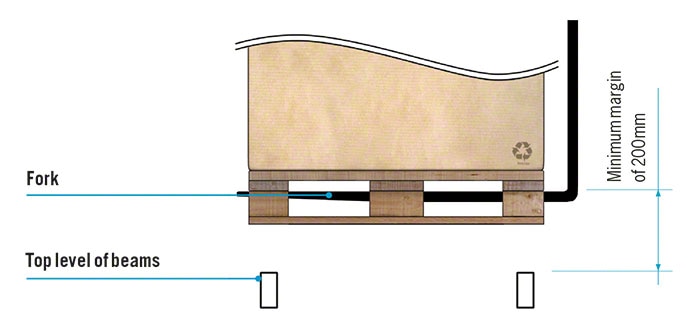
The height of the retracted mast must also be calculated, as this will determine the height of the doors and lower passageways between rack units, ceilings (if circulating below mezzanine floors), etc. The distance between the retracted mast and the ceiling or beams on top of the passageway must not be less than 500 millimetres.

A margin of 500 mm must always be left above the maximum lifting height.

Logistics warehouse.
Issues related to the use of forklifts with drive-in pallet racks
With a drive-in pallet storage system (explained in depth in another article) forklifts have to enter the aisles with the load raised, which slows return maneuvers. To speed operations up and make them safer, it is recommended that guides be placed on the floor.
One must take the width of the machine into account, leaving a 50 millimetre minimum clearance (25 mm per side) between it and the guides. If the forklift includes centring wheels, the clearance can be reduced to 10 millimetre.

When using forklift equipment in drive-in pallet racking, one must bear in mind that the first raised level of the racking unit cannot be lower than the roof of the forklift.
Should this occur, this protection may need to be modified depending on the dimensions and the system used to protect the machine, as shown in the image below.
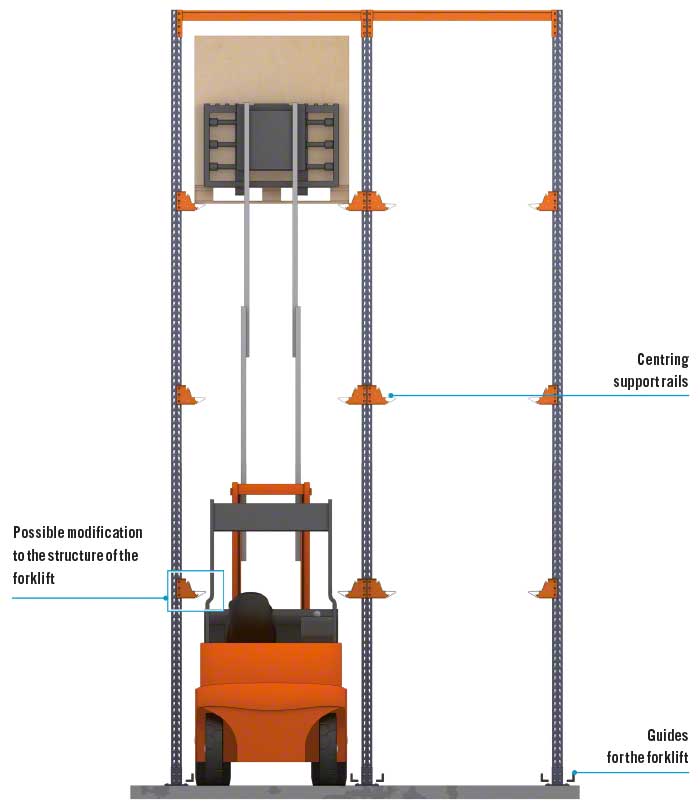
What to consider when using forklifts in drive-in racks
Clearances required with pallet rack units for each type of forklift
The following is a table of clearances which must be left in the spaces or compartments of the rack units in accordance with standard EN 15620, which has been in force since January 2009.
The machine classes mentioned are the 400 (counterbalanced and reach truck types), the 300A (VNA trucks with the operator on board) (the operator accompanies the load, man-up) and the 300B (VNA trucks with the operator on the ground (man-down), where the driver remains at ground level). The X and Y measurements are explained in the diagram accompanying the table.
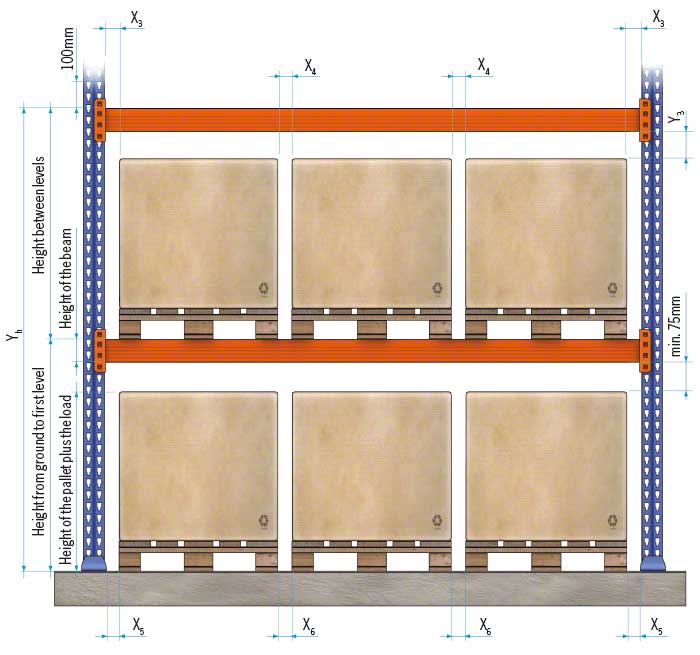
Clearances in pallet racking
| Machines | ||||||
|
For levels between (mm): |
Class 400 (mm) | Class 300A (mm) | Class 300B (mm) | |||
| X3,4,5,5 | Y3 | X3,4,5,6 | Y3 | X3,4,5,6 | Y3 | |
| 0 and 3,000 | 75 | 75 | 75 | 75 | 75 | 75 |
| 3,000 and 6,000 |
75 |
100 | 75 | 75 | 75 | 100 |
| 6,000 and 9,000 | 75 | 125 | 75 | 75 | 75 | 125 |
| 9,000 and 12,000 | 100 | 150 | 75 | 75 | 3.9 | 150 |
| 12,000 and 13,000 | 100 | 150 | 75 | 75 | 100 | 175 |
| 13,000 and 15,000 | ---- | --- | 75 | 75 | 100 | 175 |
*Table amounts represent clearances that must be left in millimetres for pallet racks per forklift type.
Clearances in the aisles where forklifts move
As mentioned earlier in the article, one must consider the height data of the forklift’s mast when retracted to ensure a suitable aisle height through which the forklift is going to move under load levels or other structures, such as mezzanine floors.
This is not the only safety measure to be met when planning aisles in a warehouse: it is just one of a number of specific standards that define the characteristics the installation in question must possess. These standards have been developed to guarantee the safety of maneuvers carried out with forklifts when these do not have guides inside the aisles.
Each country may have its own standards related to the issues written about here, which must be taken into account. The measurements set out in this article are those in force in Spain, as set out in the technical safety note number 852 concerning storage on metal racking units.
In the technical notes, it specifies that the external side frames must extend at least 500 millimetres above the top load level and 100 millimetres above the internal ones. These extensions can be provided by using structural accessories suitable for this purpose.
If upper transverse beams are used in the aisles, they must be located in the upper part so the clearance or vertical distance between them and the load or mast of the handling equipment is at least 150 millimetres.
The dimensions of the working aisles must be established based on the largest forklift that will move along them and the likelihood of people passing by.
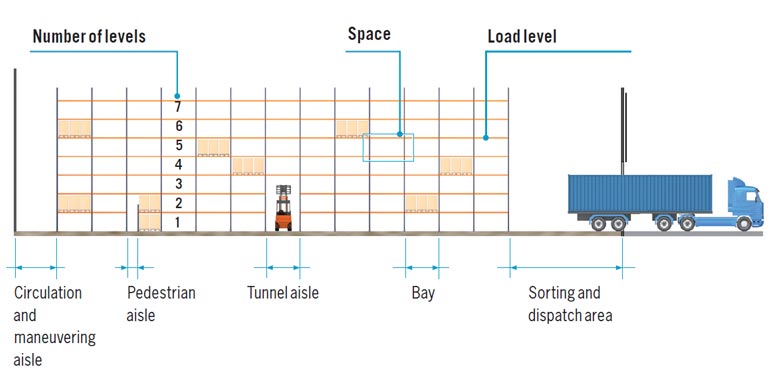
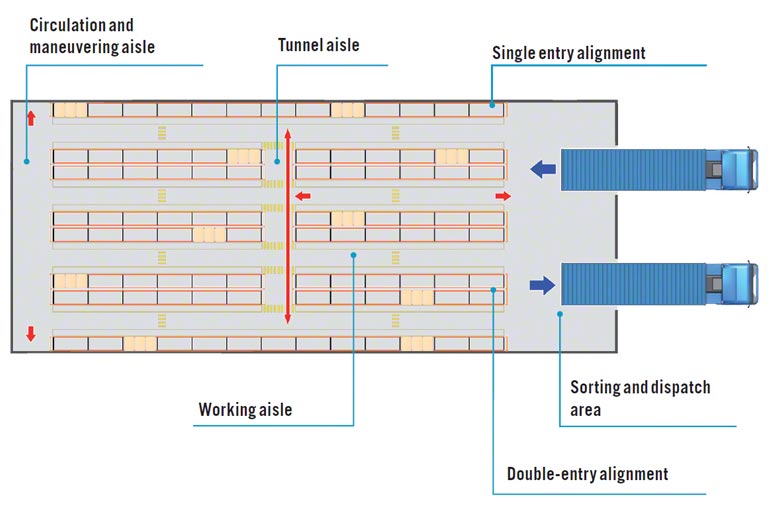
The width of one-way aisles must be no less than either the forklifts or vehicles moving in them or the largest-sized loads plus at least 600 mm, except when using turret type trucks. If pedestrians must also use these aisles, a minimum width of 3.3 ft must be retained and reserved for pedestrians only. The same rule applies to two-way aisles, but the space added to the dimensions of the largest-sized loads must be at least 900 mm.
When underpasses are used by forklifts, there must be parallel but separate passageways reserved solely for pedestrians. In terms of the width of the tunnels, the same measures apply as the ones for aisles. Since they are tunnels, there will inevitably be upper elements that can also be struck if planning is inadequate. Therefore, an additional rule is applied, which specifies that a 500 mm clearance will be the minimum passing height, either with the mast retracted and unloaded or loaded and vertically exceeding the retracted mast.
For more information about this design, refer to standards EN15512 and EN15620.

1. Safety mesh 10. Work area
